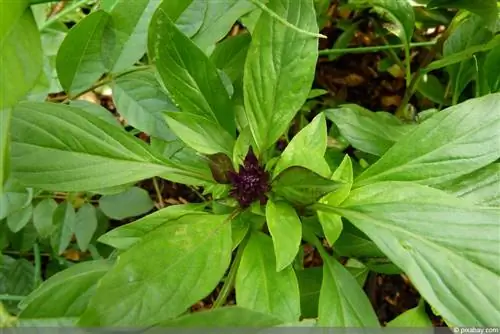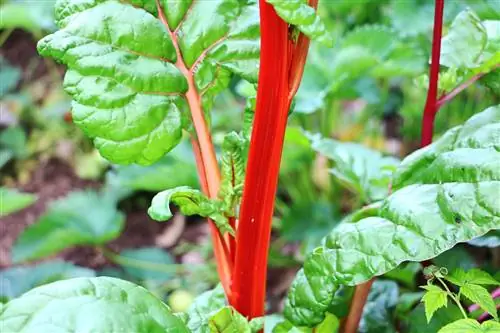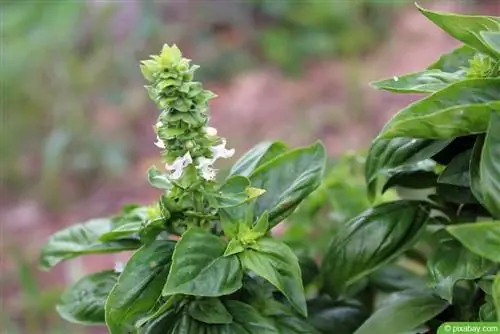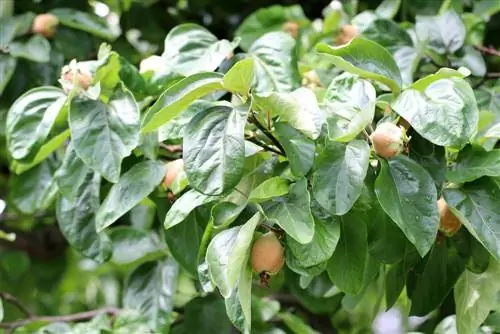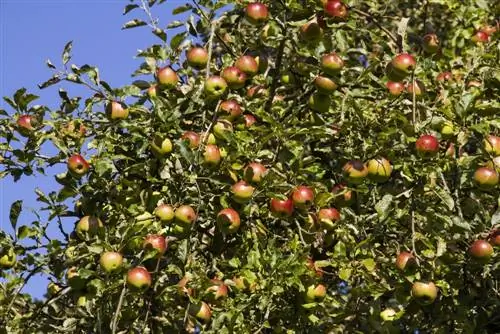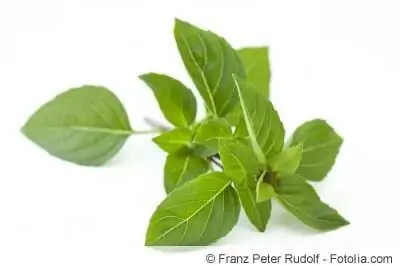- Author admin [email protected].
- Public 2023-12-17 03:39.
- Last modified 2025-01-24 12:45.
There is an herb that can combat bland food. Integrated into the multifaceted basil family, Thai basil has a special culinary status. Dried goods are not used by gourmets in the kitchen, because fresh from the herb garden the spice plays in a completely different aromatic league. A successful culture is characterized by ideal lighting conditions, adequate substrate and a balanced water and nutrient balance. The following lines explain what the location and care should be like so that a cultivation is crowned with a harvest of premium quality.
Location and substrate
As striking as Thai basil differs in taste from other species of the genus, the requirements for the location differ little. Fresh air and plenty of sunshine are the focus of this Asian spice plant. There are plenty of them in the herb bed in the garden, as well as on the balcony or terrace. The window sill is also an option as long as it is on the south or west side of the house. However, in this case, compromises have to be made in terms of the aroma content, as there is a lack of fresh air. Thai basil therefore achieves its optimum under the following conditions:
- Sunny, warm, sheltered location
- A temperature level above 20 degrees Celsius is ideal
- Nutritious, humus-rich soil
- Permeable and fresh-moist, preferably sandy-loamy
In pots and flower boxes, Thai basil thrives excellently in special herbal soil, which is usually pre-fertilized for 6 weeks. Alternatively, you can mix the three components yourself: clay, sand and compost. This has the advantage that you know exactly which nutrients are in the substrate, which will later be found in the food.
Tip:
The tomato house in the garden offers an exemplary location for Thai basil.
Care
Balance is considered the central criterion for skilful care of Thai basil. As long as the water and nutrient levels are in balance, the herb lives up to its synonymous title: king's herb. The following instructions are focused on avoiding any swings in one direction or the other. Then a few minutes of attention every day are enough and you are not forced to deal with time-consuming cultivation problems.
Watering and fertilizing
The location conditions largely determine the rhythm of the water supply. The sunnier and warmer the location, the more frequently it is watered. Basically, the watering can is used less often in the bed than in the bucket. Particularly in porous terracotta or clay pots, the wind dries out the substrate much more quickly than in the ground. How to water Thai basil correctly:
- Keep the potting soil constantly moist
- The surface should dry between waterings
- Do not use ice-cold water from the tap
- Do not water over leaves and flowers, but directly to the roots
A coaster is emptied after 20-30 minutes at the latest to prevent harmful waterlogging. If possible, water Thai basil in the morning. When exposed to direct sunlight, water droplets turn into small burning glasses that can cause significant damage to the foliage.
Tip:
You can avoid the risk of waterlogging if the root ball is immersed in water for a few minutes when it is dry.
Thai basil is not a fan of food and would like to be supplied with nutrients on a regular basis. Therefore, apply an organic fertilizer every 3 weeks during the growing season. In the bed, the combination of compost and horn shavings with the addition of granulated cattle manure is an option. Apply an adequate liquid fertilizer or organic fertilizer sticks to the bucket. If you manage a vermicompost, one portion of worm tea per week will provide the desired nutrient supply.
Harvest
The correct harvesting technique contributes significantly to maintaining the vitality of the Asian herb plant. Although some recipes in Thai or Vietnamese cuisine are based on the use of basil flowers, the flowering always marks the end of the plant's life. If you would like to harvest your Thai basil for as long as possible, proceed as follows:
- Always harvest the entire shoot and not individual leaves
- Place the harvest cutting 3-4 centimeters above the substrate
- Consistently cut out buds
If you make sure that a piece of the stem remains standing, you will encourage the growth of fresh side shoots. The result is a particularly bushy habit.
Wintering
If temperatures fall below 15 degrees, Thai basil stops growing. The season for the spice plant is over in the bed because it is not designed to overwinter outdoors. In the pot there is still the possibility of getting through the cold season on the sunny, warm windowsill. However, the only chances of success are under ideal lighting conditions. If you would like to harvest fresh leaves in winter, place a mirror behind the plant to increase the light output.
Propagate with cuttings
If the lovingly cared for herb plant is at the zenith of its vitality, this is exactly the right time for propagation. Every well-developed shoot contains the power for another Thai basil. This is how propagation with cuttings works:
- Cut off stems that are at least 10 centimeters long
- Defoliate the lower half of the shoot
- Place in a glass with willow water in a warm, partially shaded window seat
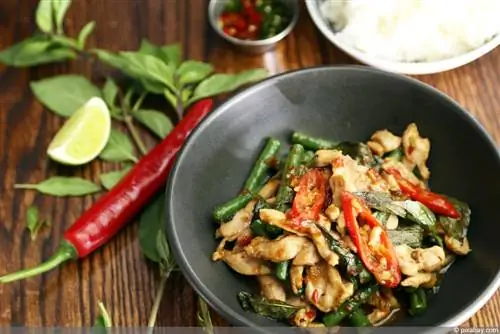
While you wait for rooting, the water is changed regularly. The risk of rot can be reduced by adding a small piece of charcoal. After 14 days, each cutting has developed its own root system. Now it's time to pot the plants in a herbal soil and sand mixture. Place a plastic bag over each growing pot to create a warm, humid microclimate. Small wooden sticks serve as spacers so that the material and the shoot do not touch each other. The substrate must not dry out afterwards. As soon as a small Thai basil sprouts, it is moved to a pot with normal substrate for adult herb plants.
Tip:
A stressed Thai basil from the supermarket does not have the potential for propagation via cuttings.
Sowing
If there is no suitable mother plant available for propagation from cuttings, sowing can be considered. In principle it is possible all year round. So that a lack of light during the darkest months of the year does not result in rotting shoots, sowing before March is not recommended. Here's how to do it:
- Fill a seed tray with peat sand, perlite, coconut fibers or commercially available seed soil
- Scatter the light germs, press them down and spray them with water
- Place in the indoor greenhouse or cover with cling film
- Keep constantly moist in a bright, not full sunny place at temperatures around 22 degrees Celsius
Under ideal conditions, germination only takes a few days. As soon as a seedling has several true leaves, it is transplanted into an individual pot with a nutritious substrate for Thai basil. Before you fill in the potting soil, place a shard of clay over the water drain in the soil. This measure makes a significant contribution to ensuring that irrigation water cannot build up.
Share purchased plants immediately
If the Thai basil appeared splendid and vital on the store shelf, the plant at home often lets its shoots hang limply after just a few days. The reason for this widespread shortcoming lies in the long transport distance and the associated stress. In addition, herb plants are usually planted far too closely in their pots. Therefore, immediately take the Thai basil out of the planter and divide it into three segments. You place these in individual pots, where the spice plants develop optimally over a long period of time under your caring hand.
Conclusion
Herb lovers with a penchant for Asian cuisine will find Thai basil an ideal spice plant. Since it is well known that dried goods hardly have any aroma, hobby gardeners plant the royal herb in their herb garden for fresh enjoyment every day. In full sun with a nutrient-rich substrate there are best prospects for a rich harvest of spicy basil leaves. Care revolves around regular watering and organic fertilization every three weeks. If there is a sunny, warm window seat available for the cold season, wintering can be successful.

